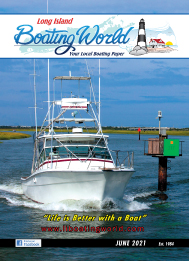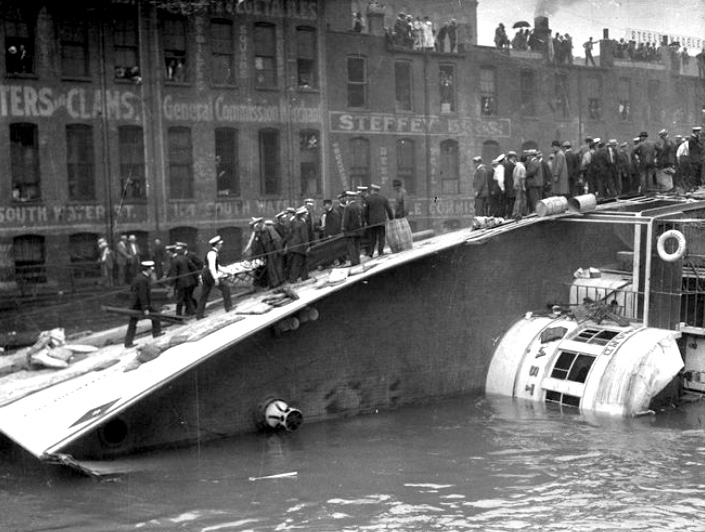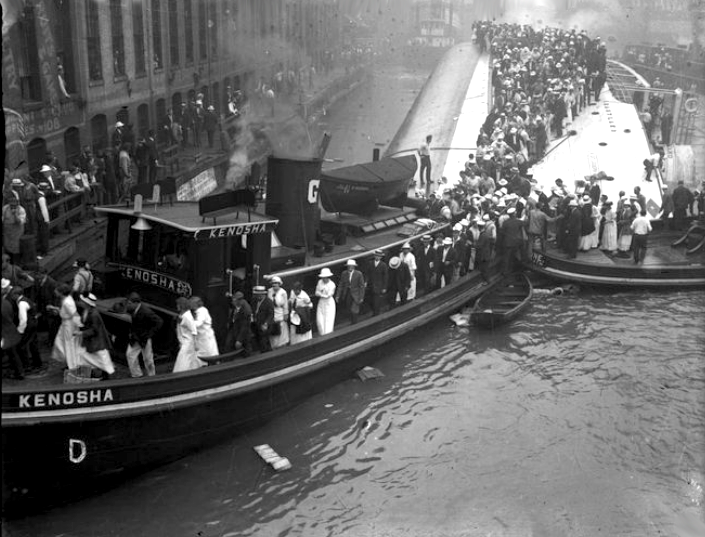
There have been many ship disasters in history accounting for large losses in lives. Most of us immediately think “Titanic – 1,128 victims, Lusitania-1,500 and the Andrea Doria – 69 (Including divers)”. All are assumed to have taken place on the ocean. They are documented by maritime historians and are supported by truckloads of backup materials. These were the most luxurious ships of their time and you had to be well-heeled to sail first class. Of course, you could sleep in a hammock in steerage, but if you went down with the ship, it wouldn’t be you on the headlines – It would be the Astors.
The Eastland was a ship chartered on July 24, 1915 by the Westinghouse Company along with five other ships to take out employees on their annual company picnic and cruise. That day 7,500 hard-working blue-collar workers and their supervisors, wives and children were looking forward to a great day as they began boarding about 7:00 a.m.

The Eastland was a 275 ft. long vessel and nicknamed “The Speed Queen”. Built in 1903, she was licensed to carry 2,570 passengers and crew. That’s roughly 12 passengers for every foot of length. Using what I call “Mark’s Mad Math” I ascertained my 18 ft. Parker could easily carry 192 passengers. Of course, there is no real parallel here, I am just pointing out that this vessel was grossly overloaded, license be damned! In addition, new rules dictating the number of lifeboats required worked against the Eastland. Because of the loss of life on the Titanic, which sank only three years previous, Eastland was required to add six extra lifeboats at 1,100 lbs. each adding 6,600 lbs. giving her 11 in all plus 2,570 life jackets weighing 15,420 lbs. total. The Eastland was too unstable under the new dictates to carry that licensed number of passengers on that or any day. Because all the lifeboats and jackets had to be accessible, they were stowed on the upper decks. In addition, some crazy s—t was done to this ship. In 1914 a large percentage of its wood floors and decks were replaced by 2” thick concrete adding another twenty tons topside.
Eastland was already deemed an “Unlucky Ship” when, just after her commissioning, she slammed into and sunk the tugboat George W. Gardener. Then, in August of 1903, her crew mutinied due to bad grub. That autumn she was returned to the shipyard for adjustments to increase her speed by modifying her hull to reduce draft while adding a weighty air conditioning system and engine modifications compromising her stability as originally designed. In 1904 she had a near capsize incident with 3,000 aboard and her capacity then was lowered to 2,800. By 1915 she was down to an allowance of 2,570 passengers. Records show continuing listing problems in 1906 and 1912.
So, it was obvious on July 24, 1915 that Eastland was in trouble before even trying to leave the dock. She listed heavily to port when too many passengers moved in bulk to that side of the ship. Once, she almost rolled over but rebounded quickly. There were Federal agents at the dock monitoring the boarding and witnessed these abnormalities but did nothing. The owners of Eastland previously warned the authorities of the ship’s stability issues, but they refused to lessen the number of lifeboats and jackets required. Of course, the smart thing for Captain Harry Peterson to do was reduce the number of passengers he would take on. As captain, he was within legal rights to do so, but “Money talks and everybody sails”, especially when your charter is Westinghouse. Besides, Eastland had made it through a long history of mishaps.
The fact is Eastland never left her dock for sea. Why? There are two good reason,s the first being that the Eastland was 750.5 miles from the nearest saltwater port and its homeport was Chicago on “LAKE” Michigan. The only H2O in sight was freshwater. You may want to argue this is nitpicking but if you look it up you will find legit reasons for keeping the definitions straight not the least of which is it would change the paradigm of this story.

The second reason Eastland never left is unbelievably tragic – All her structure issues finally took vengeance. As the last late passenger jumped on the receding gangplank, Eastland rolled radically to port, then briefly righted herself as furniture, pianos, picnic baskets slammed into passengers who were being thrown back and forth. Then she completely rolled over while still tied to the dock, in twenty feet of water. This time she did not recover.
The water surrounding Eastland became a horror show of humanity thrashing amongst floating boards, furniture, and seeping fuel. The lucky ones grabbed for each other and anything that floated. On the wharf were shops and people ran outside to help in the rescue. Many dove in the water to help women with weighty Victorian dresses to safety. It was mass confusion full of screams of fear and despair. A butcher threw his chicken crates in the water for people to grab onto. He hit one man in the head with a coop and the poor chap just sank below the water. A nurse ran to the scene and set up a triage center in a building across the street. Local hospitals filled to capacity. Most of the survivors were on deck when tragedy struck. Those who were inside the salons were not so lucky. They were trapped. If some survived a while in air pockets, the time spent recovering those on the surface sealed their fates. There was no time to rescue them. In all 844 women, children, babies and crew drowned. It was the biggest leisure craft disaster of it’s time. Oh, by the way, the captain saved himself by quickly jumping for the dock.
In the aftermath, the city of Chicago came together to help and mourn. Temporary morgues were set up so bodies could be identified by loved ones. In a few cases, no one came to promptly claim their dead as entire families had drowned. The newspapers and wire services rushed out their headlines and stories. Everyone loves a tragedy until they are in one. The famous poet and writer, Carl Sandburg was a news journalist at the time and wrote a scathing indictment accusing the owners of Eastland and the ship safety regulators of ignoring safety issues that were more than obvious. He then wrote a poem “Eastland” that was considered such a harsh indictment of all involved that it was not published until 1993.
Eventually, the tragedy became wrapped up in a steady flow of criminal and civil indictments which took years to litigate and, in the end, found no one responsible. The captain went on captaining, the same ship designers went on designing and the insurance company paid almost squat. As Bob Dylan wrote, “The ladder of justice has no top and no bottom”. He is surely right about that. The Eastland was re-floated and continued to sail under different owners until it was finally scuttled at the end of WWII after having been used as a military service training vessel.
So, what are the lessons learned from the story of the Eastland? If you really look at the giant liners floating today you have to question their seaworthiness. The largest liner is 1,188 ft. long and carries 8,980 passengers and crew. She is 238 ft. high and has a draught of only 30.7 ft. It’s not a ship I would feel comfortable on. But hey! Applying ‘Marks Mad Math” to this ship means I can carry 137 passengers on my Parker. How come the Coast Guard plate says only 7?
c. 2021 by Mark C. Nuccio, All rights reserved
Contact Mark at- mark@designedge.net.
